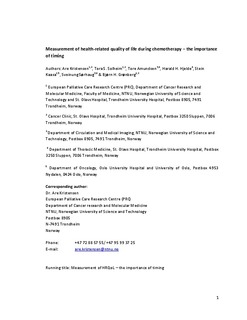| dc.contributor.author | Kristensen, Are Korsnes | |
| dc.contributor.author | Solheim, Tora Skeidsvoll | |
| dc.contributor.author | Amundsen, Tore | |
| dc.contributor.author | Hjelde, Harald Harris | |
| dc.contributor.author | Kaasa, Stein | |
| dc.contributor.author | Sørhaug, Sveinung | |
| dc.contributor.author | Grønberg, Bjørn Henning | |
| dc.date.accessioned | 2017-08-17T08:25:09Z | |
| dc.date.available | 2017-08-17T08:25:09Z | |
| dc.date.created | 2017-07-07T10:07:56Z | |
| dc.date.issued | 2017 | |
| dc.identifier.citation | Acta Oncologica. 2017, 56 (5), 737-745. | nb_NO |
| dc.identifier.issn | 0284-186X | |
| dc.identifier.uri | http://hdl.handle.net/11250/2450979 | |
| dc.description.abstract | Background: Side effects of chemotherapy may occur at different time-points in the treatment cycle, and the exact assessment time relative to chemotherapy may affect HRQoL scores. The current study examined the variation of HRQoL during chemotherapy cycles, and whether differences in HRQoL scores varied at selected time-points between patients allocated to two different chemotherapy regimens.
Material and methods: Patients with stage IIIB or IV non-small-cell lung cancer (NSCLC) were randomly assigned to receive three cycles of carboplatin plus vinorelbine (VC) or gemcitabine (GC) every 3 weeks. HRQoL was reported on the EORTC QLQ-C30 and LC13 on days 1, 4, 8, 11 and 15 of every cycle. Global health status, nausea/vomiting, fatigue and dyspnea (LC13) were defined as the HRQoL scales of primary interest.
Results: Fifty-two patients were enrolled. Variation of mean scores of global health status, nausea/vomiting and fatigue showed a consistent pattern during chemotherapy. Day 4 appeared to be the time-point when chemotherapy influenced HRQoL the most. The differences in mean HRQoL scores between the two treatment arms varied at the different time-points, especially for nausea/vomiting.
Conclusion: There was a clinically relevant variation of HRQoL during chemotherapy cycles, with increased symptom burden the first week following treatment. Our results suggest that timing of HRQoL assessment can influence the chances of detecting differences between the treatment regimens. | nb_NO |
| dc.language.iso | eng | nb_NO |
| dc.publisher | Taylor & Francis | nb_NO |
| dc.title | Measurement of health-related quality of life during chemotherapy -the importance of timing | nb_NO |
| dc.type | Journal article | nb_NO |
| dc.type | Peer reviewed | nb_NO |
| dc.description.version | acceptedVersion | nb_NO |
| dc.source.pagenumber | 737-745 | nb_NO |
| dc.source.volume | 56 | nb_NO |
| dc.source.journal | Acta Oncologica | nb_NO |
| dc.source.issue | 5 | nb_NO |
| dc.identifier.doi | 10.1080/0284186X.2017.1279748 | |
| dc.identifier.cristin | 1481389 | |
| dc.description.localcode | This is an Accepted Manuscript of an article published by Taylor & Francis in Acta Oncologica on 24 Jan 2017, available online: http://www.tandfonline.com/doi/full/10.1080/0284186X.2017.1279748 . Locked until 24 January 2018 due to copyright restrictions. | nb_NO |
| cristin.unitcode | 194,65,25,0 | |
| cristin.unitcode | 194,65,15,0 | |
| cristin.unitname | Institutt for sirkulasjon og bildediagnostikk | |
| cristin.unitname | Institutt for kreftforskning og molekylær medisin | |
| cristin.ispublished | true | |
| cristin.fulltext | postprint | |
| cristin.qualitycode | 1 | |
